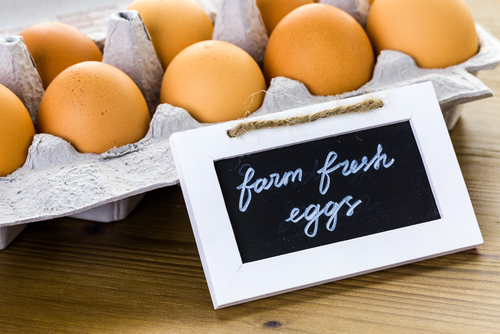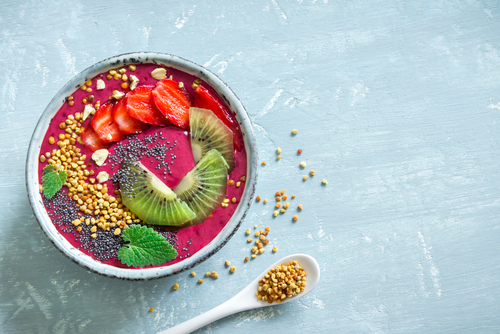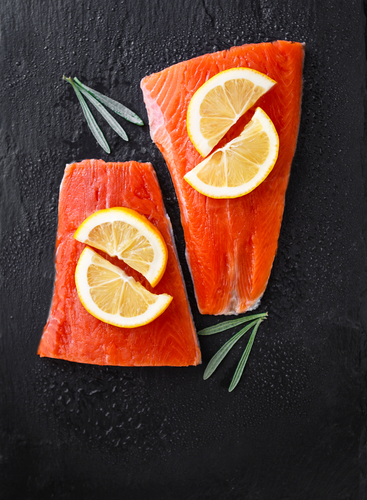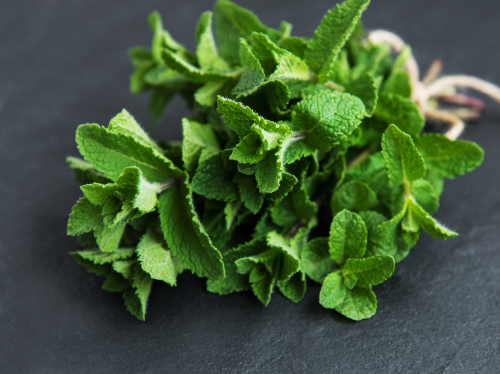Seasonality just ain’t what it used to be.
With the advent of climate control and long-range shipping, we can get pretty much any product we want at any time.
But still — any foodie worth their weight in black truffle sea salt knows that there’s no comparing fresh, seasonally-fitting food to the standard year-round stuff.
You can get some of these 5 foods at other times during the year. But trust us — they’ll never taste better than they will right now.

Farm-fresh eggs
Did you know: to amp up their egg production, factory-farmed chickens are exposed to artificial light?
It’s a fact: chickens lay best when they get 14+ hours of light per day.
If you’re buying supermarket eggs, the seasons won’t affect availability. But — if you’re scoping out farmers markets for free-roaming chicken eggs, you’ll see a sudden increase in eggs due to the extra hours of spring daylight that cause the chickens to lay at peak production.
Make the most of these healthy, freshly-laid chicken eggs while they’re readily available. For purest flavor, prepare the eggs hard-boiled or poached — frying them in oil or butter will mask some of the egg’s delicious flavor.
Put some spring in your salad with hard-boiled eggs in a lettuce-and-tuna-based Niçoise Salad, or a potato salad with seasonal new potatoes and scallions.
Keep it kosher tip: When purchasing eggs at a farmers market, make sure you can recognize the eggs as chicken eggs. Some rare breeds lay eggs that are a unique color, like blue-green, or are in other ways not readily identified as sourced from a chicken.

Bee pollen
Bee pollen is considered by some to be true miracle food. Rich in protein and a spectrum of nutrients and enzymes, these golden granules have been said to enhance immunity, improve alertness, and even halt seasonal allergies.
Spring-harvested bee pollen originate from spring wildflowers, such as clover and dandelion, and some say it has a sweeter taste than pollen collected later in the year.
Try sprinkling the pollen grains on smoothies, cereal, oatmeal, fruit salad, or on a piece of toast with ricotta cheese.
Keep it kosher tip: Bee pollen is kosher as long as it is 100% bee pollen, with no other ingredients added.

Wild Alaskan Salmon
This immensely popular coral-colored fish has a season — and it’s happening right now.
Farmed salmon is available year-round, but if you want the best stuff — that is, wild salmon harvested from the cold waters of Alaska — the peak season begins in late spring.
There’s no limit to the ways you can enjoy fresh wild salmon. As with other seasonally fresh items, you’ll be able to most appreciate the perfect palatability of wild salmon with the most simple method of prep; too many complex ingredients will only disguise the delicious flavor.
We love Passover Made Easy’s Jalapeño-Lime-and-Ginger Salmon and Dining In’s Aromatic Baked Salmon.
Keep it kosher tip: According to the OU fish guidelines, the characteristic red-orange flesh of salmon is an acceptable identifying kosher mark — that means that as long as you recognize the fish as salmon, you can purchase it without the skin.
Another concern is how the fish has been cut: there is no issue if the fish was cut in a large-scale factory — however, if the fish was cut in a local or smaller-scale store, there may be issues with a non-kosher knife. (Find out more here.)

Mint
This gorgeous aromatic herb is widely-available during springtime. With its cooling properties, mint is used to balance the spiciness in some of the world’s heat-loving cuisines, such as those of the Middle East or Southeast Asia. And it’s the perfect herb for the locally warming weather.
Experience the freshness of mint in savory dishes, such as Estee Kafra’s Chicken Steaks with Golden Berry Orange Gremolata, or in a refreshing cocktail, like Kiki Fisher’s Strawberry Lime Mojitos.
Keep it kosher tip: Fresh herbs require inspection for insects. See the OU’s method for checking herbs, including basil, cilantro, dill, and mint.

Rosé wine
We change our wardrobe with the seasons, so why not change our wine?
In fact, master sommeliers have long recommended switching your wines with the seasons. While winter and fall wines are generally full-bodied and layered (think: pinot noir and cabernet), spring and summer wines are crisp and light (think: moscato and rosé).
Ranging in color from pale pink to dark pinkish-red, rosé wines pair marvelously with the delicate flavors of spring produce.
Keep it kosher tip: Here’s an easy one! Whether imported from Israel, France, Spain, or New Zealand, the kosher wine industry offers a large selection of trendy and high-quality rosé wines with kosher certification.





